Things to see with a small telescope or binoculars
You just need a little guidance. There are lots of wonderful things that beginners can find with just a small telescope or a pair of binoculars
If you are new to the whole hobby of astronomy and telescopes you are probably wondering what kinds of things you can see with just something basic like a small telescope or a pair of binoculars. Well, there are lots of interesting things you can see and your first few ventures out into the night sky can be very rewarding. You just have to know where to look. In this article I will point some of the best things out for you.
I live in the northern hemisphere so this stuff will mostly focus on things in this sky. Although there are a couple of things that I will point out in the southern hemisphere.
Before You Start – There are a couple of things you will need and need to know.
1. First off the night sky is ever rotating and the Earth is going around the sun which means that various things are only visible during certain times of the year. There are certain things that can only be seen during summer or winter. I will point out these things as needed.
2. You will need some kind of a star chart or star map. It is the only way to find anything at all! We find things by referring to the various constellations in the sky and you need a chart to find them!
Things to See
 The Moon – This is the first thing that everybody turns to and it is great for a small telescope or a pair of binoculars. But one thing a lot of people don’t realize is that a full moon is not so good for looking at. It is too bright and there are no shadows. The smaller the sliver of moon the better the viewing. So if you look at the full moon and are a bit disappointed just come back to it in a week or two when it becomes just a sliver. You will be delighted at the detail you see. When the moon is a sliver the sun is shining on it at a very sharp angle which causes very long shadows. These long shadows bring out all the details of the craters.
The Moon – This is the first thing that everybody turns to and it is great for a small telescope or a pair of binoculars. But one thing a lot of people don’t realize is that a full moon is not so good for looking at. It is too bright and there are no shadows. The smaller the sliver of moon the better the viewing. So if you look at the full moon and are a bit disappointed just come back to it in a week or two when it becomes just a sliver. You will be delighted at the detail you see. When the moon is a sliver the sun is shining on it at a very sharp angle which causes very long shadows. These long shadows bring out all the details of the craters.
The Planets – There are five planets that are easily found with a small scope or binoculars. They are Mercury, Venus, Mars, Jupiter, and Saturn. You will be able to distinguish the unique color that each planet has and for Jupiter you will probably be able to see the belts across its middle. And for Saturn you will be able to see it as an squashed blog or possibly as having rings around it. In order to find these with any certainty you should use a planetary chart. That would be something like this:

It gives you a representation of the night sky and on this particular chart the planets are labeled with a letter. U is Uranus, N is Neptune, J is Jupiter etc. But you can see how they are referenced by constellations. So you need to spend a little time learning how to identify the constellations so you can find the planets.
Sky and Telescope Magazine has an easy reference for finding stuff in tonights night sky here
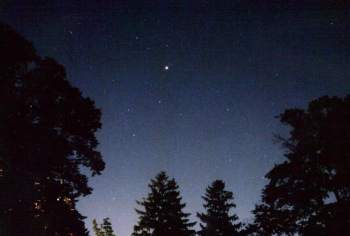 The planets are ever changing and ever moving during the course of the year so there is no particular place to look if you want to find them. You will need a star chart that shows the current location in order to find them. But…. often times Venus, Mars, Jupiter, and Saturn are among the brightest things in the sky. So, if you see a very bright star you should take a look at it through your scope or binoculars. You might be surprised to see that it is a planet!
The planets are ever changing and ever moving during the course of the year so there is no particular place to look if you want to find them. You will need a star chart that shows the current location in order to find them. But…. often times Venus, Mars, Jupiter, and Saturn are among the brightest things in the sky. So, if you see a very bright star you should take a look at it through your scope or binoculars. You might be surprised to see that it is a planet!
In the case of Venus it is often near the horizon and only visible for a period of time after sunset or before sunrise. This is because of its proximity to the sun. But Venus can get very bright so it is easy to spot.
The picture shown here is of Jupiter in the constellation Sagittarius. You can see how it is pretty bright! Point your binoculars at it! I took this photo with a 35mm film camera.
Deep Sky Objects – This is a pretty general term and it refers to various objects like Nebulae and other Galaxies. There are a few of these that you can see with the naked eye and that come alive with even a small telescope or a pair of binoculars. These kinds of objects are seasonal and can only be seen during certain times of the year. (The following three star maps are Copyright © 2003 Torsten Bronger .)
In Summer –
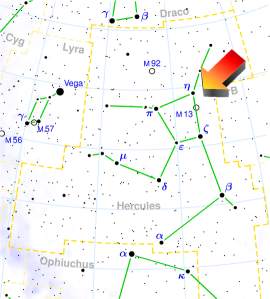 M13 – This is a wonderful globular cluster of stars in the constellation of Hercules. Once you spot the constellation you should be able to see the M13 Cluster with the naked eye. Then you can point your scope or binoculars at it. An easy reference to finding hercules is the star of Vega. It is a very bright star.
M13 – This is a wonderful globular cluster of stars in the constellation of Hercules. Once you spot the constellation you should be able to see the M13 Cluster with the naked eye. Then you can point your scope or binoculars at it. An easy reference to finding hercules is the star of Vega. It is a very bright star.

M 31- The Andromeda Galaxy – This is a spectacular Galaxy that can first be found with the naked eye. It too will look like a little puff of cottonball. An easy way to find it is to first find the four stars that make up the constellation Pegasus. From there you can trace up the stars of the constellation andromeda.
In Winter:
 M42 ( The Orion Nebula) This is a beautiful Nebula that is in the middle of Orion’s Sword which hangs from his belt. You can first find it with the naked eye then point your telescope at it. Some easy ways to find this are first by finding the Star Sirius which is the brightest star in the sky. Or you can easily find the constellation of Orion because it is pretty bright. Then the three stars of Orions belt are easily seen. From there you just look a little below his belt.
M42 ( The Orion Nebula) This is a beautiful Nebula that is in the middle of Orion’s Sword which hangs from his belt. You can first find it with the naked eye then point your telescope at it. Some easy ways to find this are first by finding the Star Sirius which is the brightest star in the sky. Or you can easily find the constellation of Orion because it is pretty bright. Then the three stars of Orions belt are easily seen. From there you just look a little below his belt.
Summary
There are lots of amazing and wonderful things to see in the night sky. It does take a little bit of know how to find them but it is well worth the effort!
Lots more interesting articles on telescopes and astronomy right here
RESOURCES
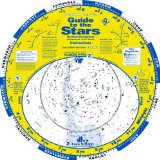 Guide to the Stars Star Charts come in a lot of different styles, types and sizes. You can get complete books (recommended if you are a serious amateur who really wants to dig into the hobby) or easy to use star wheels that you rotate according to the date and time (recommended for beginners)
Guide to the Stars Star Charts come in a lot of different styles, types and sizes. You can get complete books (recommended if you are a serious amateur who really wants to dig into the hobby) or easy to use star wheels that you rotate according to the date and time (recommended for beginners)
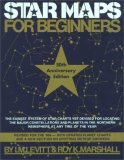 Star Maps for Beginners: 50th Anniversary Edition
Star Maps for Beginners: 50th Anniversary Edition
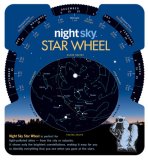 Night Sky Star Wheel
Night Sky Star Wheel
